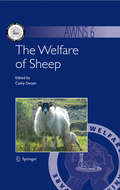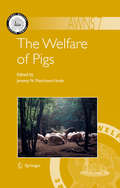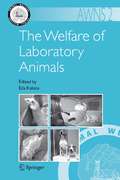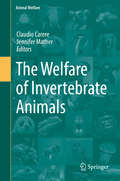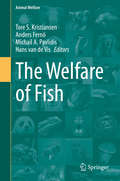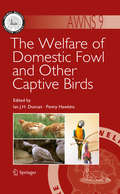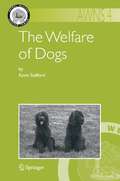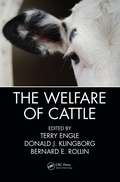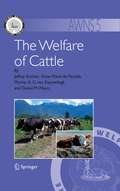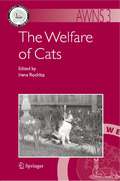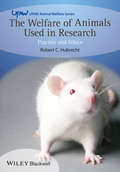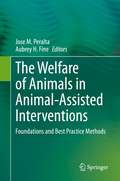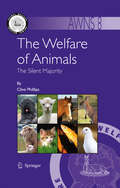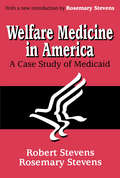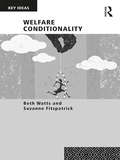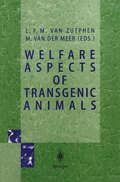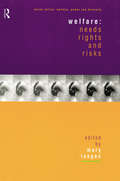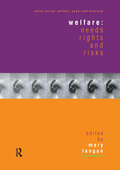- Table View
- List View
The Welfare of Sheep (Animal Welfare #6)
by Cathy DwyerAnimal welfare is attracting increasing interest worldwide, but particularly from those in developed countries, who now have the knowledge and resources to be able to improve the welfare of farm animals. The increased attention given to farm animal welfare in the West derives largely from the fact that the relentless pursuit of ?nancial reward and ef?ciency has led to the development of intensive animal production systems that disturb the conscience of many consumers. In developing countries, human survival is still a daily uncertainty, so that provision for animal welfare has to be balanced against human welfare. Welfare is usually provided for only if it supports the output of the animal, be it food, work, clothing, sport or companionship. In reality there are resources for all if they are properly husbanded in both developing and developed countries. The inequitable division of the world’s riches creates physical and psychological poverty for humans and animals alike in many sectors of the world. Livestock are the world’s biggest land user (FAO, 2002) and the population is increasing rapidly to meet the need of an expanding human population. Populations of farm animals managed by humans are therefore incre- ing worldwide, and in some regions there is a tendency to allocate fewer resources, such as labour, to each animal with potentially adverse consequences on the a- mals’ welfare.
The Welfare of Pigs (Animal Welfare #7)
by Jeremy N. Marchant-FordeThe domestic pig is perceived as an animal with intelligence and character and yet, in the industrialized world, the majority of people have had little or no contact with them. Pigs are subject to a wide range of environments from the tropics to the sub-arctic, ranging from small-scale, extensive systems to large-scale intensive systems. They may spend their whole life on one farm or may be subject to long-distance transport multiple times. Not surprisingly, many aspects of their life experiences can impact their welfare. This book brings together a team of leading pig welfare research scientists to review the natural history of the pig, the welfare of pigs at different stages of life and to indicate what the future holds in terms of pig welfare. The text is aimed at researchers and teachers working in veterinary and animal science together with those working in the pig industry and for governmental and non-governmental animal welfare organizations.
The Welfare of Laboratory Animals (Animal Welfare #2)
by Eila KalisteThis book examines the general principles of laboratory animal maintenance and experimental use as well as factors that have to be taken into account when good research is done with animals. In addition, it provides species specific coverage, concentrating on the species most used as laboratory animals. The book gives a comprehensive description of the welfare questions considered to be important for each species under laboratory conditions.
The Welfare of Invertebrate Animals (Animal Welfare #18)
by Claudio Carere Jennifer MatherThis book is devoted to the welfare of invertebrates, which make up 99% of animal species on earth. Addressing animal welfare, we do not often think of invertebrates; in fact we seldom consider them to be deserving of welfare evaluation. And yet we should. Welfare is a broad concern for any animal that we house, control or utilize – and we utilize invertebrates a lot. The Authors start with an emphasis on the values of non-vertebrate animals and discuss the need for a book on the present topic. The following chapters focus on specific taxa, tackling questions that are most appropriate to each one. What is pain in crustaceans, and how might we prevent it? How do we ensure that octopuses are not bored? What do bees need to thrive, pollinate our plants and give us honey? Since invertebrates have distinct personalities and some social animals have group personalities, how do we consider this? And, as in the European Union’s application of welfare consideration to cephalopods, how do the practical regulatory issues play out?We have previously relegated invertebrates to the category ‘things’ and did not worry about their treatment. New research suggest that some invertebrates such as cephalopods and crustaceans can have pain and suffering, might also have consciousness and awareness. Also, good welfare is going to mean different things to spiders, bees, corals, etc. This book is taking animal welfare in a very different direction. Academics and students of animal welfare science, those who keep invertebrates for scientific research or in service to the goals of humans, as well as philosophers will find this work thought-provoking, instructive and informative.
The Welfare of Fish (Animal Welfare #20)
by Tore S. Kristiansen Anders Fernö Michail A. Pavlidis Hans van de VisThis book investigates how fish experience their lives, their amazing senses and abilities, and how human actions impact their quality of life. The authors examine the concept of fish welfare and the scientific knowledge behind the inclusion of fish within the moral circle, and how this knowledge can change the way we treat fish in the future. In many countries fish are already protected by animal welfare legislation in the same way as mammals, but in practice there is still a major gap between how we ethically view these groups and how we actually treat them. The poor treatment of fish represents a massive animal welfare problem in aquaculture and fisheries, both in terms of the number of animals affected and the severity of the welfare issues. Thanks to its interdisciplinary scope, this thought-provoking book appeals to professionals, academics and students in the fields of animal welfare, cognition and physiology, as well as fisheries and aquaculture management.
The Welfare of Domestic Fowl and Other Captive Birds (Animal Welfare #9)
by Ian J. H. Duncan Penny HawkinsAnimal welfare is attracting increasing interest worldwide, especially in developed countries where the knowledge and resources are available to (at least potentially) provide better management systems for farm animals, as well as companion, zoo and laboratory animals. The key requirements for adequate food, water, a suitable environment, appropriate companionship and good health are important for animals kept for all of these purposes. There has been increased attention given to farm animal welfare in many co- tries in recent years. This derives largely from the fact that the relentless pursuit of nancial reward and ef ciency, to satisfy market demands, has led to the devel- ment of intensive animal production systems that challenge the conscience of many consumers in those countries. In developing countries, human survival is still a daily uncertainty, so that p- vision for animal welfare has to be balanced against human needs. Animal welfare is usually a priority only if it supports the output of the animal, be it food, work, clothing, sport or companionship. In principle the welfare needs of both humans and animals can be provided for, in both developing and developed countries, if resources are properly husbanded. In reality, however, the inequitable division of the world’s riches creates physical and psychological poverty for humans and a- mals alike in many parts of the world.
The Welfare of Dogs (Animal Welfare #4)
by Kevin StaffordThis book is one of a series of textbooks on the Welfare of Animals. This book discusses the welfare of dogs used for many different purposes. The book has an international perspective on the welfare of dogs in developed and under-developed countries. The welfare of laboratory dogs which is of concern to many people is discussed, as is the welfare of animals held in shelters waiting for re-homing or euthanasia. The book successfully combines an appreciation of how the health and nutrition of dogs has improved with an understanding of the social difficulties dogs experience. The book’s outlook on the subject of dog welfare is positive.
The Welfare of Cattle
by Terry Engle Donald J. Klingborg, DVM Bernard E. RollinContains a selection of White Papers, commissioned to better inform the exploration of cattle welfare. These are prepared by notable experts in their field, to help provide factual context around selected topics that impact cattle welfare and production systems. Covers all aspects of cattle use in an accessible style, making this a must have volume for anyone interested in cattle welfare or cattle medicine. Provides an in-depth picture of the distinctive beef and dairy cattle welfare practices and issues, covering topics such as behavior, breeding and genetic manipulation, nutrition and feeding, housing and management, health and disease, and transport and slaughter. Written by acknowledged leaders in animal science, veterinary science, philosophy and animal welfare, presenting a truly multidisciplinary perspective on cattle welfare. Includes a section on understanding and managing animal welfare in both beef and dairy cattle, discussing how cattle perceive the world, animal handling and pain mitigation, and how to assure that the cows have a reasonably good life. The Welfare of Cattle offers an accurate, detailed account of the ethical and welfare concerns related to the human use of cattle. There is currently no significant book dealing with the welfare of cows, animals often seen as archetypal paradigms of 'farm animals'. Covering both beef and dairy cattle, the expert authors provide in-depth information on the husbandry roots of traditional agriculture, the replacement of this system of stewardship by an industrial model, and the resulting welfare challenges associated with industrial agriculture: feedlots, highly industrialized dairies, and slaughterhouses killing huge numbers of animals who have been transported great distances. This important book explores in detail the ways in which people who are providing care for cattle can take their first step, or their next step, toward enhancing the welfare of these animals. An extra chapter (online only) is available in the 'Downloads' tab on the left: Dairy Nutrition, by Michael Gamroth
The Welfare of Cattle
by Bernard E. Rollin Terry Engle Donald J. Klingborg, DVMContains a selection of White Papers, commissioned to better inform the exploration of cattle welfare. These are prepared by notable experts in their field, to help provide factual context around selected topics that impact cattle welfare and production systems. Covers all aspects of cattle use in an accessible style, making this a must have volume for anyone interested in cattle welfare or cattle medicine. Provides an in-depth picture of the distinctive beef and dairy cattle welfare practices and issues, covering topics such as behavior, breeding and genetic manipulation, nutrition and feeding, housing and management, health and disease, and transport and slaughter. Written by acknowledged leaders in animal science, veterinary science, philosophy and animal welfare, presenting a truly multidisciplinary perspective on cattle welfare. Includes a section on understanding and managing animal welfare in both beef and dairy cattle, discussing how cattle perceive the world, animal handling and pain mitigation, and how to assure that the cows have a reasonably good life. The Welfare of Cattle offers an accurate, detailed account of the ethical and welfare concerns related to the human use of cattle. There is currently no significant book dealing with the welfare of cows, animals often seen as archetypal paradigms of 'farm animals'. Covering both beef and dairy cattle, the expert authors provide in-depth information on the husbandry roots of traditional agriculture, the replacement of this system of stewardship by an industrial model, and the resulting welfare challenges associated with industrial agriculture: feedlots, highly industrialized dairies, and slaughterhouses killing huge numbers of animals who have been transported great distances. This important book explores in detail the ways in which people who are providing care for cattle can take their first step, or their next step, toward enhancing the welfare of these animals. An extra chapter (online only) is available in the 'Downloads' tab on the left: Dairy Nutrition, by Michael Gamroth
The Welfare of Cattle (Animal Welfare #5)
by Jeffrey Rushen Anne Marie Passillé Marina A. Keyserlingk Daniel M. WearyThis book covers all aspects of research into the welfare of dairy, veal and beef cattle, covering behavior, nutrition and feeding, housing and management, stockmanship, and stress physiology, as well as transport and slaughter. It also offers a detailed and critical analysis of the main indicators of animal welfare and covers the main threats to animal welfare in modern cattle production systems.
The Welfare of Cats (Animal Welfare #3)
by Irene RochlitzWritten by experts from the UK, the USA and Switzerland, this book focuses on the major issues affecting the welfare of domestic cats. It covers behaviour, the human-cat relationship, and the impact of housing, disease, nutrition and breeding on welfare.
The Welfare of Animals Used in Research: Practice and Ethics (UFAW Animal Welfare)
by Robert C. HubrechtThe Welfare of Animals used in Research: Practice and Ethics gives a complete and balanced overview of the issues surrounding the use of animals in scientific research. The focus of the book is on the animal welfare implications and ethics of animals in research. It covers the topics with sufficient depth to show a real understanding of varied and complex subjects, but conveys the information in a beautifully reader-friendly manner. Key features: Provides those who are not working in the field with a reasonable understanding as to why and how animals are used in research. Gives an introduction to the ethical issues involved in using animals, and explains how these are addressed in practice. Details the advances in animal welfare and the use and development of the 3Rs principles, and how these have become fundamental to the everyday use and regulation of animals used in research. The focus is on principles making it suitable for an international audience. This book is a useful introduction to the issues involved in laboratory animal welfare for those who intend to work in research involving animals. It is also useful to prospective animal care staff and animal welfare scientists, and to those involved in ethical review. It will help inform debate amongst those who are not involved in experimentation but who are interested in the issues. Published as a part of the prestigious Wiley-Blackwell – UFAW Animal Welfare series. UFAW, founded 1926, is an internationally recognised, independent, scientific and educational animal welfare charity. For full details of all titles available in the series, please visit the UFAW Animal Welfare series website.
The Welfare of Animals Used in Research: Practice and Ethics (UFAW Animal Welfare)
by Robert C. HubrechtThe Welfare of Animals used in Research: Practice and Ethics gives a complete and balanced overview of the issues surrounding the use of animals in scientific research. The focus of the book is on the animal welfare implications and ethics of animals in research. It covers the topics with sufficient depth to show a real understanding of varied and complex subjects, but conveys the information in a beautifully reader-friendly manner. Key features: Provides those who are not working in the field with a reasonable understanding as to why and how animals are used in research. Gives an introduction to the ethical issues involved in using animals, and explains how these are addressed in practice. Details the advances in animal welfare and the use and development of the 3Rs principles, and how these have become fundamental to the everyday use and regulation of animals used in research. The focus is on principles making it suitable for an international audience. This book is a useful introduction to the issues involved in laboratory animal welfare for those who intend to work in research involving animals. It is also useful to prospective animal care staff and animal welfare scientists, and to those involved in ethical review. It will help inform debate amongst those who are not involved in experimentation but who are interested in the issues. Published as a part of the prestigious Wiley-Blackwell – UFAW Animal Welfare series. UFAW, founded 1926, is an internationally recognised, independent, scientific and educational animal welfare charity. For full details of all titles available in the series, please visit the UFAW Animal Welfare series website.
The Welfare of Animals in Animal-Assisted Interventions: Foundations and Best Practice Methods
by Jose M. Peralta Aubrey H. FineThis is the first book focusing on the animal’s perspective and best practices to ensure the welfare of both therapy animals and their human counterparts in animal-assisted interventions. Written by leading scientists, it summarizes the scientific evidence available concerning the impacts on animals in these settings, including companion species, horses, marine mammals and other animals used in therapy.There has been a dramatic increase in the range of animal-assisted interventions used in medical and allied health environments in recent years, and the field is now entering an era with a greater interest in defining the underlying mechanisms of the human-animal bond as well as the therapeutic benefits of these interactions. Animal-assisted interventions, as with other uses of animals by humans, impose a unique set of stresses on the animals, which the community has only recently begun to acknowledge. For the field to continue to flourish, more evidence is needed to shed light on the implications for the animals and what guidelines need to be put into practice to ensure welfare.With the ultimate goal of improving the impact that we have on the animals under our care, the book provides a roadmap for researchers and clinicians as they attempt to safely and humanely incorporate various species of animals into therapeutic settings. The authors also offer instructions and suggestions for areas that need to be studied more robustly over the next decade to continue to ensure the safe and proper use of animals in therapy sessions.This is an informative, thought-provoking and instructive resource for practitioners and researchers in the field of medicine and clinical psychology using animal-assisted interventions, as well as for veterinarians and welfare scientists.
The Welfare of Animals: The Silent Majority (Animal Welfare #8)
by Clive PhillipsThe Welfare of Animals is an exciting book that will stimulate and provoke its readers. It describes many problems faced by animals – those we use for food, for pleasure or in research, and those simply but harshly affected by shrinking habitats in the face of the ever-growing human population. And yet it is not a depressing read. It focuses not only on the difficulties that animals face, but on their capacity for free-choice, for joy and excitement, and on the possible ways in which the planet can be shared between species if only we take the time and trouble to think more carefully about the impact of our actions. Clive Phillips moved from the United Kingdom to take up a Foundation Chair in Animal Welfare at the University of Queensland, becoming Australia’s first Professor of Animal Welfare in 2003. This cultural leap, combined with his travels in countries like Malaysia and Borneo, permits him the unique and broad perspective that forms the backbone of this book. Eschewing the normal territory patrolled by the animal scientist (explaining the physiological basis of the stress response or causation of abnormal behaviour), Clive ventures into jungles and deserts, city centres and tribal homelands, and presents a book that remarkably and successfully combines travel-diary, nature notes, social and cultural history.
Welfare Medicine in America: A Case Study of Medicaid
by Rosemary A. StevensThe present study was undertaken for three reasons: Medicaid is a vital program-in the early 1970s it provided care for over one tenth of the American population. It is a huge program-in the same period it consumed over nine billion dollars of public funds. And Medicaid is, in many ways, the most direct involvement with the provision of medical care undertaken by either the federal government or the states. But until the publication of this book, Medicaid had not been studied in depth or in a systematic way. Welfare Medicine in America is the complete history of Medicaid. The authors carefully examine the program's historical antecedents, its strengths, and its weaknesses. In part one, "The Coming of Medicaid," the hows and whys of the establishment of Medicaid are discussed, as are the basic provisions of the program. In part two, "The Euphoric Demise: July 1965-January 1968," the focus is on how Medicaid is administered in the states. In part three, "The Storm: January 1968-July 1970," specific amendments to Medicaid, the costs involved, and other health programs are examined. And in part four, "Benign Neglect: July 1970-June 1973," the role of the courts in administering Medicaid, and its future, are the primary subjects. This history of Medicare, however, goes beyond the specific government program itself and offers a paradigm for inquiring into the problems of medical care in general and the nature and limitations of public medical services. Welfare Medicine in America is a profound analysis of Medicaid and welfare systems, and will be of great use to policymakers, students of welfare and government, and to those working within the medical profession.
Welfare Medicine in America: A Case Study of Medicaid
by Rosemary A. StevensThe present study was undertaken for three reasons: Medicaid is a vital program-in the early 1970s it provided care for over one tenth of the American population. It is a huge program-in the same period it consumed over nine billion dollars of public funds. And Medicaid is, in many ways, the most direct involvement with the provision of medical care undertaken by either the federal government or the states. But until the publication of this book, Medicaid had not been studied in depth or in a systematic way. Welfare Medicine in America is the complete history of Medicaid. The authors carefully examine the program's historical antecedents, its strengths, and its weaknesses. In part one, "The Coming of Medicaid," the hows and whys of the establishment of Medicaid are discussed, as are the basic provisions of the program. In part two, "The Euphoric Demise: July 1965-January 1968," the focus is on how Medicaid is administered in the states. In part three, "The Storm: January 1968-July 1970," specific amendments to Medicaid, the costs involved, and other health programs are examined. And in part four, "Benign Neglect: July 1970-June 1973," the role of the courts in administering Medicaid, and its future, are the primary subjects. This history of Medicare, however, goes beyond the specific government program itself and offers a paradigm for inquiring into the problems of medical care in general and the nature and limitations of public medical services. Welfare Medicine in America is a profound analysis of Medicaid and welfare systems, and will be of great use to policymakers, students of welfare and government, and to those working within the medical profession.
Welfare, Exclusion and Political Agency
by Janet Batsleer Beth HumphriesWelfare, Exclusion and Politcal Agency develops key topics in social work and social policy relating to exclusion, social divisions and control in welfare. It provides theoretical tools for students, academics and professionals whose work involves them in supporting the political agency of excluded groups. At a time when there have been profound shifts in the organization of welfare and the underpinning theories of the associated professions, the book tackles issues such as: *the move away from publicly funded welfare *the loss of a public service ethic *reduction of input from professionals in policy *loss of professional skills *increase of bureaucracy.
Welfare, Exclusion and Political Agency
by Janet Batsleer Beth HumphriesWelfare, Exclusion and Politcal Agency develops key topics in social work and social policy relating to exclusion, social divisions and control in welfare. It provides theoretical tools for students, academics and professionals whose work involves them in supporting the political agency of excluded groups. At a time when there have been profound shifts in the organization of welfare and the underpinning theories of the associated professions, the book tackles issues such as: *the move away from publicly funded welfare *the loss of a public service ethic *reduction of input from professionals in policy *loss of professional skills *increase of bureaucracy.
Welfare Conditionality (Key Ideas)
by Beth Watts Suzanne FitzpatrickWelfare conditionality has become an idea of global significance in recent years. A ‘hot topic’ in North America, Australia, and across Europe, it has been linked to austerity politics, and the rise of foodbanks and destitution. In the Global South, where publicly funded welfare protection systems are often absent, conditional approaches have become a key tool employed by organisations pursuing human development goals. The essence of welfare conditionality lies in requirements for people to behave in prescribed ways in order to access cash benefits or other welfare support. These conditions are typically enforced through benefit ‘sanctions’ of various kinds, reflecting a new vision of ‘welfare’, focused more on promoting ‘pro-social’ behaviour than on protecting people against classic ‘social risks’ like unemployment. This new book in Routledge’s Key Ideas series charts the rise of behavioural conditionality in welfare systems across the globe, its appeal to politicians of Right and Left, and its application to a growing range of social problems. Crucially it explores why, in the context of widespread use of conditional approaches as well as apparently strong public support, both the efficacy and the ethics of welfare conditionality remain so controversial. As such, Welfare Conditionality is essential reading for students, researchers, and commentators in social and public policy, as well as those designing and implementing welfare policies.
Welfare Aspects of Transgenic Animals: Proceedings EC-Workshop of October 30, 1995
by Miriam Van Der Meer L. F. M Van Zutphenv Preface The quality of animal models used in biomedical research has increased substantially since the first successful microinjection of foreign DNA frag ments into a mouse zygote in the early 1980s. New well-defined animal models, developed either by micro injection techniques or by homologous recombination in embryonic stem (ES) cells, have become widely available and several classical animal models have now been replaced by these transgenic models. Transgenic animals also fulfill increasingly important roles in other fields, like livestock production or in biopharming. The potential benefits of this technology are overwhelming. It is not surprising that many research groups have rushed to jump on this wagon of scientific progress. However, no matter how important these developments are, they can not relieve us of the moral obligations towards the animals. It is generally recognized that animal use is allowed only if the harmful effects are out weighed by the potential benefits of the experimental results. But what are the harmful effects? What is the impact of trans genesis on the well-being of animals? In order to gain more insight into this aspect of trans genesis the European Commission (DGXII) has funded a 12-month project with the aim of col lecting information on the production and use of transgenic animals in EU Member States and, more specifically, to obtain information as to what extent specific welfare problems may arise and whether or not studies are being performed on the incidence of welfare problems.
Welfare and Old Age in Europe and North America: The Development of Social Insurance (Perspectives in Economic and Social History)
by Bernard HarrisOver the last twenty years, historians have become increasingly interested in the role of non-state organizations in the development of welfare services. This study is particularly focused on the role of friendly societies and other insurance bodies in the provision of aid for the elderly and the sick.
Welfare and Old Age in Europe and North America: The Development of Social Insurance (Perspectives in Economic and Social History #21)
by Bernard HarrisOver the last twenty years, historians have become increasingly interested in the role of non-state organizations in the development of welfare services. This study is particularly focused on the role of friendly societies and other insurance bodies in the provision of aid for the elderly and the sick.
Welfare: Needs, Rights and Risks
by Mary LanganWelfare: Needs, Rights and Risks addresses the question of how people get access to social welfare in the UK today. It explores the public, political and professional definitions, constructions and conflicts about who should receive social welfare and under what conditions. In a period during which the rationing, targeting and selective provision of welfare have become more significant, more visible and more disputed, this book examines how individuals and groups come to be defined as in need, at risk or deserving of welfare.
Welfare: Needs, Rights and Risks (Social Policy: Welfare, Power and Diversity)
by Mary LanganWelfare: Needs, Rights and Risks addresses the question of how people get access to social welfare in the UK today. It explores the public, political and professional definitions, constructions and conflicts about who should receive social welfare and under what conditions. In a period during which the rationing, targeting and selective provision of welfare have become more significant, more visible and more disputed, this book examines how individuals and groups come to be defined as in need, at risk or deserving of welfare.
